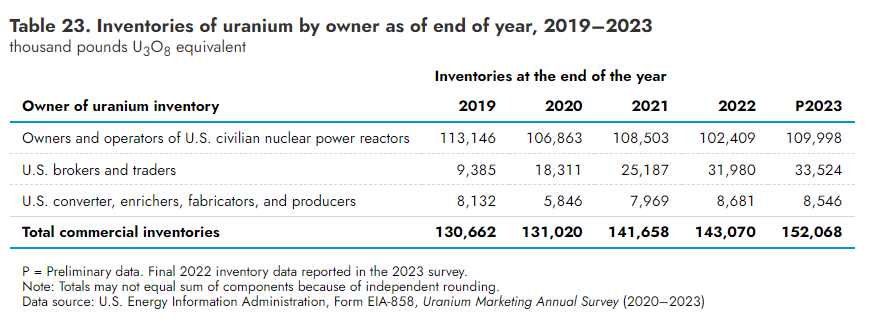Uranium Data Program Disclosure Review Report
UDP Disclosure Report_FINAL_4.11.2025.docx
Uranium Data Program
Uranium Data Program Disclosure Review Report
OMB: 1905-0160

April
2025
Disclosure
Analysis Review Report: Changes to the display of U3O8 data
www.eia.gov U.S.
Department of Energy
Washington,
DC 20585





Background
The U.S. Energy Information Administration ensures that data publications are consistent with disclosure avoidance techniques when a commitment has been made to protect the confidentiality of sensitive data collected and published in our statistical products. Specific to the Uranium Data Program (UDP), all information collected on the Form EIA-858 Uranium Marketing Annual other than production volumes have data protections applied to them prior to publication. This includes inventories of U3O8 equivalent.
The current protections employ the p percent rule that applies disclosure protection to sensitive cells that have concentration of the sensitive data series. This test ensures any data element that is overly concentrated in too few respondents will be withheld so individual survey response data is masked. Any data element that receives less than three responses is also automatically withheld.
Included in the current terms of clearance for the Uranium Data Program Information Collection Review, the Office of Management and Budget requested a Disclosure Analysis Review of changes to the display of U3O8 equivalent inventory data requested by a set of industry stakeholders.
Terms of Clearance
UDP package received approval for one year while changes to the display were reviewed. EIA's response to a detailed set of questions from the Ad hoc Utility Group (AHUG) request named concerns that need to be balanced. Specifically, the terms of clearance stated:
It is unclear how AHUG requests 2a-2c could allow identification of proprietary firm-level information for groups in the named industry concentration chart that are comprised of at least 8 firms, or why an industry group would make a request that would identify proprietary information about its members. Research this request in more depth, and include a short report in the next 1905-0160 ICR package, considering that similar charts might be created that offer most of the AHUG information (noted as already public), but that may -- while conveying more detail -- block only a small subset of the data points associated with the chart in order to protect from firm-level identification. This may even be to the level of the 2d question (breaking out by type), as submitted in AHUG's comment. The report should clearly indicate where privacy concerns are binding constraints for each facet of the AHUG 2a-2d comment, and demonstrate examples of feasible tables that balance the concerns of accuracy, privacy, and economically useful industry information for the public and as requested by representatives of that industry.
This report describes the options evaluated and recommendations made for changes to our current data display, while maintaining compliance with our statistical standards of disclosure avoidance techniques.
Current display
U3O8 equivalent inventory data are included in the Uranium Marketing Annual Report Table 22 and Table 23 of the report (see below).


As shown on Table 22 some of the data are currently withheld for certain types of U3O8 equivalent inventory categories, specifically Natural UF6 and Enriched UF6 inventories held by U.S. suppliers of uranium even though they are at the national level.
Included in the terms of clearance for the current collection was a request to evaluate more granular displays of inventories of U3O8 equivalent within eight equal numbered groups of survey respondents and within the types of uranium fuel groupings currently displayed (comment 2d). This level of granularity would violate our current disclosure techniques and would result in a significant increase in the number of cells withheld to avoid disclosure and potentially result in fewer data elements in total due to the need for complementary suppression. Complementary suppression is the withholding of enough secondary data cells to prevent a viewer from using statistical techniques to reveal a small number of withheld primary data cells.
Table 1: 2023 Disclosure Analysis Review |
|
|
|
||
|
# of respondents |
U3O8 |
Natural UF6 |
Enriched UF6 |
Fabricated Fuel |
Group 1 |
5 |
|
|
|
|
Group 2 |
5 |
|
|
|
|
Group 3 |
5 |
|
|
|
|
Group 4 |
5 |
|
|
|
|
Group 5 |
5 |
|
|
|
|
Group 6 |
5 |
|
|
|
|
Group 7 |
5 |
|
|
|
|
Group 8 |
8 |
|
|
|
|
Green = Publishable |
|
|
|
|
|
Red = Not publishable |
|
|
|
|
|
To meet the request for additional displays of data, two alternative options were considered.
Options Considered and Recommendation
After conducting a thorough review of recent annual Form EIA-858 data submissions, there are two reasonable options to accommodate the request for more granular displays of inventory data.
The first option is a standardized and more-robust table/chart aggregating material by U3O8 equivalent only. This should be a repeatable table/chart every year, producing a consistent data set over many years and would include more data groups (more groups = more granular groupings). The drawback is that it displays all data in one dataset as U3O8 equivalent as opposed to separate categories for each material type.
Option A.
Table 22 B. Combined uranium inventories grouped by utility group as of end of year 2023
thousand pounds of U3O8 equivalent
|
# of respondents |
All inventories |
Group 1 |
7 |
|
Group 2 |
7 |
|
Group 3 |
7 |
|
Group 4 |
7 |
|
Group 5 |
7 |
|
Group 6 |
8 |
|
Green = Publishable |
|
|
The second option would be an attempt to publish more material types (U3O8, Natural UF6, Enriched UF6. Fabricated Fuel), but it requires fewer groups of respondents (fewer groups = more respondents in each group and less granular) than originally planned. In years with robust and less-concentrated survey responses, more data will be published. However, there will be many data cells that need to be withheld. Additionally, due to complementary suppression rules, there will be some information withheld that is currently published in national level inventories that would need to be withheld to mask primary suppression data cells.
Different data cells may/will need to be withheld each year so data sets will be less consistent over time than if the first option is used. In addition, 2023 inventory data included the highest uranium inventories held by respondents on record, so any declines in inventory going forward will lead to more data needing to be withheld.
Option B.
Table 22 B. Inventories of natural and enriched uranium by material type and utility group as of end of year 2023
thousand pounds of U3O8 equivalent
|
# of respondents |
U3O8 |
Natural UF6 |
Enriched UF6 |
Fabricated Fuel |
Group 1 |
7 |
|
|
|
|
Group 2 |
7 |
|
|
|
|
Group 3 |
7 |
|
|
|
|
Group 4 |
7 |
|
|
|
|
Group 5 |
7 |
|
|
|
|
Group 6 |
8 |
|
|
|
|
Green = Publishable |
|
|
|
|
|
Red = Not publishable |
|
|
|
|
|
Conclusion
After discussing these options with industry stakeholders, EIA recommends adopting Option B as a new table named 22 B as this is the preferred Option of the industry stakeholders. EIA staff has made it clear to stakeholders that in some years a significant amount of data may need to be withheld. The existing Table 22 (Inventories of natural and enriched uranium by material type) will be renamed Table 22 A.
Option B also partially satisfies comments 2a by including the number of respondents in each group. Because EIA does not collect inventories of uranium at a reactor level, we are concerned publishing inventories with the number of reactors implies an inventory management strategy that may not be the case. Collecting inventories at a reactor level represents an additional burden for both EIA and respondents to the Form EIA-858. Inventories would need to be added to the survey or need to be independently gathered and assigned to respondents in each group, but there are no disclosure issues as long as the data cell itself can be published. Comment 2b (Add the exact percentage to each group) can be added to the new data without confidentiality concerns also given that the data cell itself can be published.
Similarly regarding 2c, “Normalizing how the inventory is depicted: specifically, instead of using just pounds equivalent, taking inventory totals reported in Item 2 of the survey and dividing this by the average of the last three years reported for Item 4 (to capture different reload cycles,” EIA finds that normalizing the inventory will negatively impact respondents as well as strain EIA’s limited resources. Every nuclear reactor operates under unique and often confidential circumstances and schedules. Additionally, this would entail significant work and increase EIA’s IT burden, which could lead to results that might not be wholly accurate, given assumptions EIA would have to make on the operational schedules of individual reactors. Such modeling falls out of the realm of the statistical survey work EIA performs.
These changes will require enhancements to the dissemination systems as well as outreach with data users to explain the need for cell suppression. EIA plans to implement the new table in the data year (2025 data published in 2026) following approval of this collection package (currently scheduled for publication in the summer of 2025), if resources allow.
| File Type | application/vnd.openxmlformats-officedocument.wordprocessingml.document |
| File Title | Dependent Interviewing in the Annual Electric Generator Report (EIA-860 |
| Subject | Disclosure Analysis Review Report |
| Author | Brown, Tyson |
| File Modified | 0000-00-00 |
| File Created | 2025-05-19 |
© 2025 OMB.report | Privacy Policy